Sanma Shioyaki is one of the most well-known seasonal fish recipes representing autumn in Japanese cuisine. Pacific saury is salted and grilled whole and served with grated daikon and soy sauce to intensify the flavor of the fish.
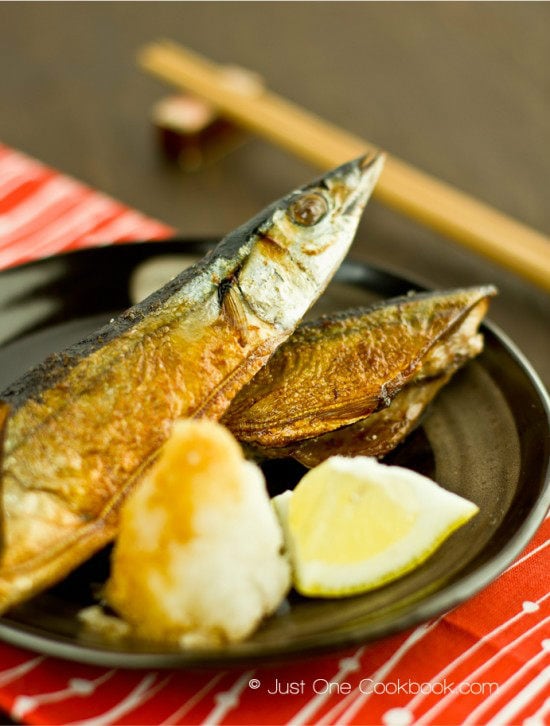
Sanma or Pacific Saury is one of the most well-known seasonal fish representing autumn in Japanese cuisine. It’s usually salted and grilled whole even with intestines intact, and served with grated daikon and soy sauce to intensify the flavor of the fish. The Japanese enjoy the combination of the bitter intestine flavor with fresh grated daikon soy sauce. The kanji characters used in the Japanese names of the Sanma (秋刀魚) mean “autumn sword fish” in reference to sanma season and its body shape resembling a knife or a sword.
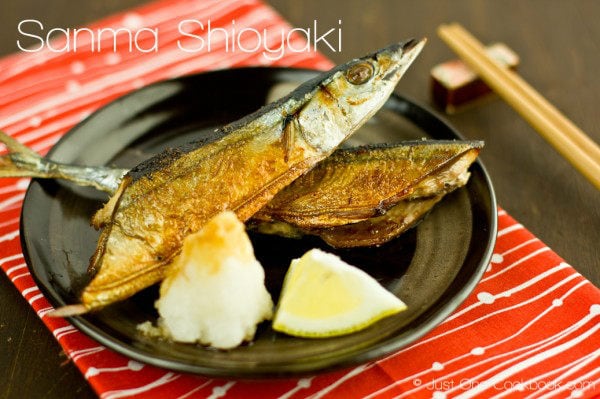
If you can grill sanma over charcoal, the smokiness adds another layer of flavor to the dish. However, I like using my oven toaster to grill my fish because it’s simple and easy to clean up. You can use an oven or a broiler, but please adjust the cooking time accordingly. I will be sharing another Sanma dish next week before the sanma season is over. This time I wasn’t scared to show fish head picture. Do you remember my post that I was concerned about publishing because I thought it’s scary looking? Well I received very positive responses last time from majority of readers who are used to fish heads so I am more confident this time to share the photos today. I hope I didn’t scare you this time… Have a great week everyone!
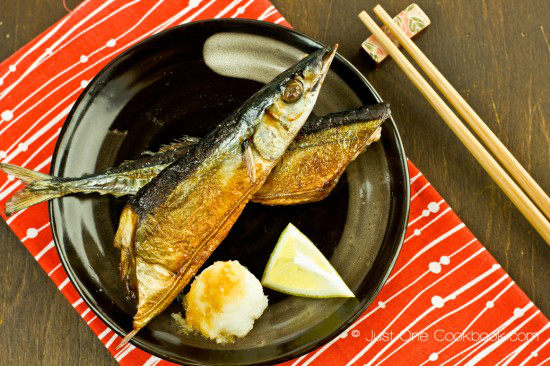
Wish to learn more about Japanese cooking? Sign up for our free newsletter to receive cooking tips & recipe updates! And stay in touch with me on Facebook, Pinterest, YouTube, and Instagram.
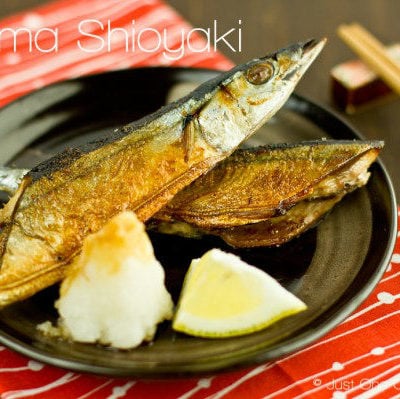
Sanma Shioyaki (Salt-Grilled Pacific Saury)
Ingredients
- 1 Pacific saury (sanma)
- 1 Tbsp sake
- Diamond Crystal kosher salt
- 1 inch daikon radish (peel and grate it (I like this grater) and squeeze out some of the moisture; you don‘t need to use all of it)
- 1 Tbsp soy sauce
- 1 wedge lemon (optional)
Instructions
- Cut 1 Pacific saury (sanma) in half diagonally (to fit in my toaster oven). Place the fish vertically on the cutting board and insert a knife in the stomach side from top to bottom. Wash and get rid of the guts thoroughly in cold water. Wipe the entire fish dry with paper towels.

- In a bowl, put the fish and 1 Tbsp sake and leave it for 5 minutes. Sake helps to make the fish fluffier and to remove the unwanted odor.

- After 5 minutes, remove the moisture on the fish with paper towels. Right before broiling or baking, sprinkle both sides of the fish with Diamond Crystal kosher salt.

To Broil (Recommended)
- Preheat the broiler* with a rack placed about 6 inches (15 cm) away from the top heating element (in the middle) for 3 minutes. Line a baking sheet with foil for easy cleaning (brush/spray the foil with oil or wrinkle up the foil so the skin doesn‘t stick). Place the fish on the baking sheet. Broil it on Medium/High until the surface is blistered and brown a bit, about 8–10 minutes, flipping once. *Typical broiler setting: Low 450ºF/232ºC, Medium 500ºF/260ºC, and High 550ºF/288ºC.

To Bake (Optional)
- Preheat the oven to 425°F (218ºC) with a rack placed in the middle and bake the fish on parchment paper until the surface is blistered and brown a bit, about 10–15 minutes, flipping once.
To Serve
- Serve with a 1 wedge lemon and the grated daikon from 1 inch daikon radish. Drizzle 1 Tbsp soy sauce over the grated daikon and enjoy it with the fish.
To Store
- You can keep the leftovers in an airtight container and store in the refrigerator for up to 2 days.
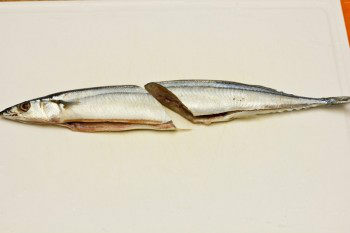
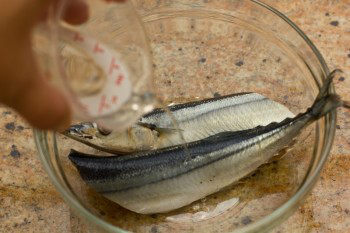
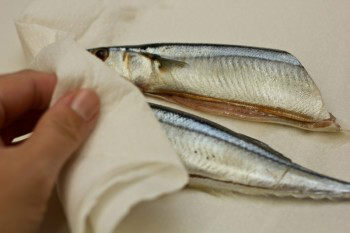
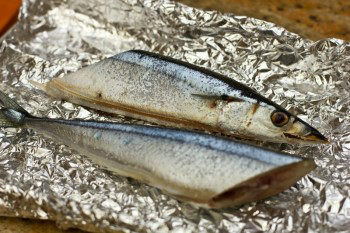










Hi Nami! We made this recipe for dinner and my family absolutely loved it, even my kids! The taste was amazing. However, there were quite a lot of bones in the sanma. We did our best to remove them but we probably ate some accidentally. Is that ok? How do you remove all those little bones?
Hello Laura! Thank you for trying Nami’s recipe! We are thrilled to hear that you and your family enjoyed Sanma Shioyaki.
Here is the best way to eat Sanma: Although the instruction is in Japanese, we hope you can read it with the help of Google Translate.😉
If you have any questions or concerns, please do not hesitate to reach out to us. We are always happy to help!
https://topics.tbs.co.jp/article/detail/?id=1779
Hi Namiko! I enjoyed making this recipe. Like always, I’m blown away by how simple the dishes that I enjoyed all growing up are! Tastes just like when I was living at home with my dad! Thank you 💜
Hi, キャセデぃ! We are so happy to hear you enjoyed this dish! Thank you very much for trying this recipe and for your kind feedback!
Hi Nami,
The recipe looks amazing and I would like to try it. How would you cook 3 of them in an oven?
Hi Kit! Use a broiler. If you don’t have a broiler setting in your oven, use high heat 450-500 ºF to cook the fish. 🙂
Hi Nami-san, I’ve found Saury in my local market in New Zealand and so keen to try this recipe, however I don’t have a toaster grill and can’t seem to work my oven right.
Is it possible to use the pan instead?
Thank you!
Hi Sheila! You found Saury! Yes, you can use a frying pan with a little bit of oil (it’s easier with non-stick – but use a small amount of oil). If it’s long, cut in half. You can cover to steam cook (no water) on low heat but make it crisp at the end. Hope you enjoy!
[…] It’s usually salted and grilled whole even with intestines intact, and served with grated daikon and soy sauce to intensify the flavor of the fish…Get the recipe at Just One Cookbook […]
Just a heads up to anyone looking for Sanma in American markets. I’ve noticed some markets (including my local Atlanta markets) use another name for Sanma: Mackerel Pike. From my understanding, Pacific Saury and Mackerel Pike are the same fish.
Now Sanma/Pacific Saury/Mackerel Pike is a completely different fish than Atlantic Mackerel (sometimes called Norwegian Mackerel or just Mackerel), which I believe is Saba in Japanese. They look very different as well.
Hi Nelson! Thank you so much for sharing the information! Sometimes it’s really hard to know the right translation for the fish. 🙁
I love this recipe! You have made me a fan of sanma. However, one time the sanma had an off (kind of metallic) taste. I was wondering if an body else had this problem. I thought maybe i did not clean it well enough. But other than that this fish is fantastic. Thank you Nami.
Hi Rachel! Thank you for your kind feedback! I’m so glad to hear you like Sanma! 🙂 Could it be the taste of guts?
Thank you for this recipe.. I am going to try it tonight.. Just wondering if I dont have sake, I can substitute it for anything else?
Hi Rena! I hope you enjoy! If you don’t have sake, then how about white wine (dry sherry)? It’s basically to remove “fishy” smell. If you have any other method in your cuisine to remove fish smell, that works too. 🙂
I really enjoy your recipes and thanks so much for sharing. One feedback on this recipe though: I was looking where the soy sauce was used, after a while then I realized it is for the daikon. Perhaps you could state that so that it is clear.
Hi Meng! Thank you for pointing that out! I just updated the recipe. I’m happy to hear you enjoy my recipes, and thank you so much!
this fish is VERY good. the only bad thing about cooking it is the smell. i couldn’t believe how strong this fish smells during (and after) cooking. but the taste is worth it! has anyone tried scoring the fish on its sides before cooking?
Hi Jayson! I guess I’m really used to cooking fish that I didn’t even feel bothered by the smell at all (haha!).
About scoring the skin of fish, I actually did for one of the fish but it didn’t look good enough for photo shoot.. 😉 If you don’t cut the fish in half like I did above, it’s probably better to score. 🙂
焼くところに少しお酢を塗ると、焼き終えた時にキレイに取れるらしいですよ。科学関係らしいですけど。。。
Aiko-san, コメントありがとうございます!お酢とは初めて知りました!是非次回やってみます!実験楽しみ~!
***
Aiko told us another method: applying vinegar with a brush on the foil so the skin won’t stick to the foil. I have to try this next time!